
Pomfret
 The town without hope. Why would I start an article with these words? This is because that is what I found in Pomfret. Here is its story.
Pomfret was a mining town, mining for asbestos. Apart from that it was also at one time an army base, and today, a head ache for the government. It is situated about 200 km north-west of Vryburg, it's geo-location: 25.8323°S, 23.5264°E and 1158m altitude.
The town without hope. Why would I start an article with these words? This is because that is what I found in Pomfret. Here is its story.
Pomfret was a mining town, mining for asbestos. Apart from that it was also at one time an army base, and today, a head ache for the government. It is situated about 200 km north-west of Vryburg, it's geo-location: 25.8323°S, 23.5264°E and 1158m altitude.
Asbestos mine
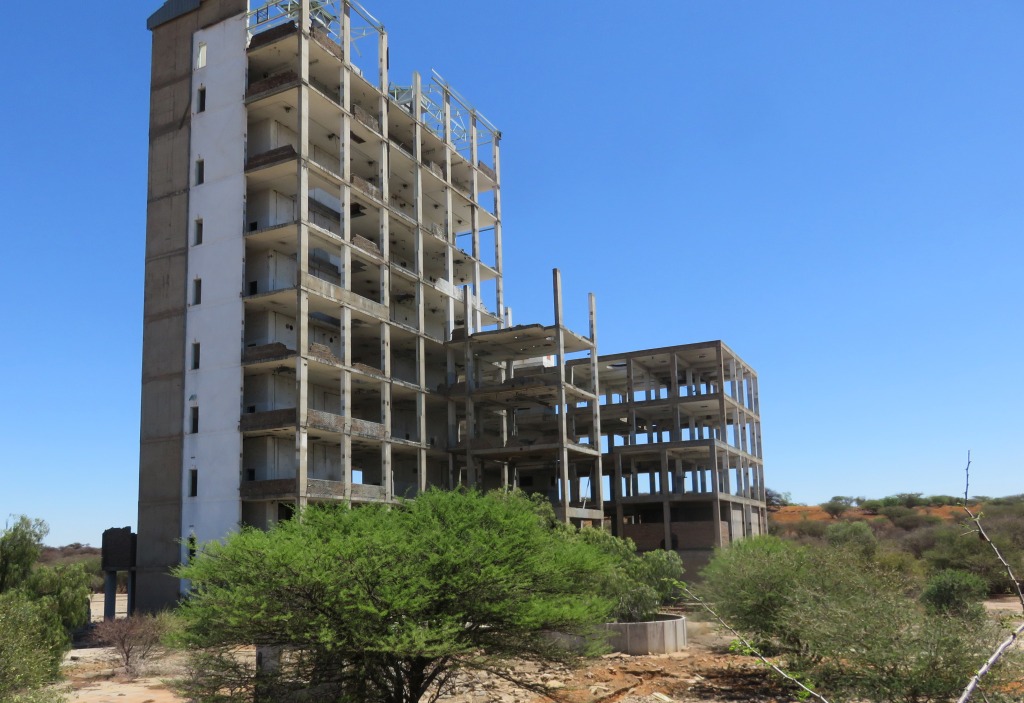
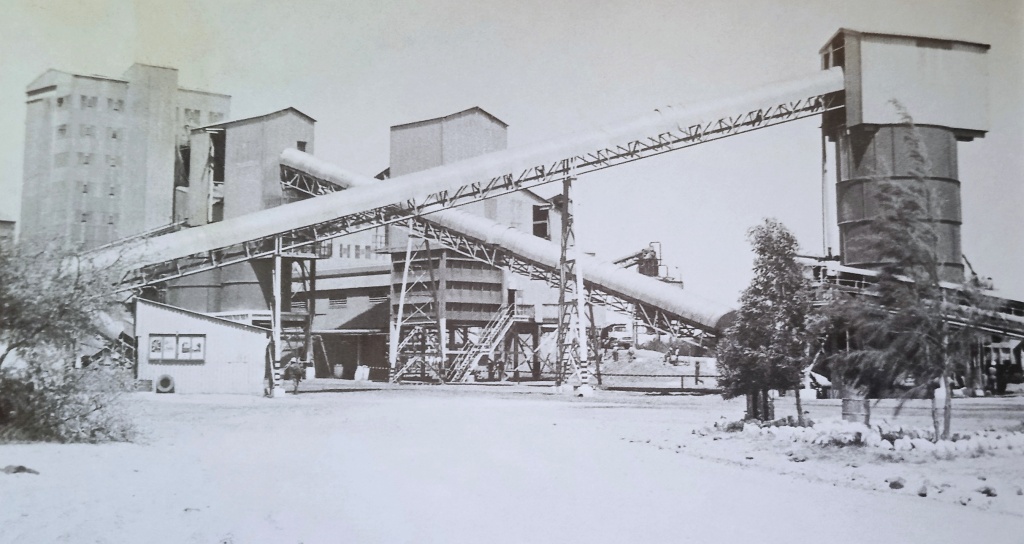 In the common sources one reads that the asbestos mine started in 1969. But, according to an article by H.P.Hart in Ref 1, mining in the area was first started by the Cape Asbestos Company in 1926. The production during 1927 was at a rate of 4 tons per month. Another deposit found in 1944 increased the production to 300 tons per month. I am not sure what development took place in 1969. The next date mentioned is 1978, that is when the mill opened. That is the large building shown in the pictures, on the left what it looked like when it was running and on the right now from Ref 2.
In the common sources one reads that the asbestos mine started in 1969. But, according to an article by H.P.Hart in Ref 1, mining in the area was first started by the Cape Asbestos Company in 1926. The production during 1927 was at a rate of 4 tons per month. Another deposit found in 1944 increased the production to 300 tons per month. I am not sure what development took place in 1969. The next date mentioned is 1978, that is when the mill opened. That is the large building shown in the pictures, on the left what it looked like when it was running and on the right now from Ref 2.
 According to ref 1 the mine did have the usual infrastructure, that is houses and recreation club for the white staff. The black staff would have been housed in the compound. One has to remember that this was the time when the group areas act was in force. Thus there was no township, that must have come later when the army took over the place and established a base. In fact the Google Earth image of 1985 shows that there was no township, but 2005 it was there. Thus the conclusion, the township was mainly developed to house the soldiers of the 32 Battalion.
According to ref 1 the mine did have the usual infrastructure, that is houses and recreation club for the white staff. The black staff would have been housed in the compound. One has to remember that this was the time when the group areas act was in force. Thus there was no township, that must have come later when the army took over the place and established a base. In fact the Google Earth image of 1985 shows that there was no township, but 2005 it was there. Thus the conclusion, the township was mainly developed to house the soldiers of the 32 Battalion.
The recreation club was fairly large, apart from the bar, lounge and hall, I also identified two swimming pools, a tennis court (2) and a bowling green. I may have seen a squash court, but I am not sure now. Everything, of course, is in ruins with all recyclable material removed.
 Just off to the north-east of the 'white' town is what used to be the shopping centre. To my mind it's far to big for the population during the mining days. We found this Kontantwinkel (cash bazaar) and petrol station, just outside. It is not operating any-more, we were told that this was the mine shop. Interesting to note that this shop still has all its window frames and the roof. The horse- or donkey cart parked indicates that there is still some activity. I would think the shopping centre was erected for the army base.
Just off to the north-east of the 'white' town is what used to be the shopping centre. To my mind it's far to big for the population during the mining days. We found this Kontantwinkel (cash bazaar) and petrol station, just outside. It is not operating any-more, we were told that this was the mine shop. Interesting to note that this shop still has all its window frames and the roof. The horse- or donkey cart parked indicates that there is still some activity. I would think the shopping centre was erected for the army base.
SA army base
At the end of the war in Angola and Namibia and with the independence of Namibia, the South African army had to withdraw from the territory. In that process the army base at Pomfret was developed. That was in 1989. Pomfred was mainly the base for the 32-Battalion.
From here they were sent on various duties, which included to patrol the unruly townships. This they had not been trained for and it came to an incident when a number of civilians were shot and killed in Phola Park in Gauteng. It led to the disbandment of the battalion in March 1993.
They were spread over a number of other units, one of them was 2-SAI to be stationed in Pomfret. When that unit was later transferred to Zeerust many of the soldiers handed in their resignation,  preferring to rather stay on in Pomfret. About 250, now ex-soldiers stayed behind. And many of them are still here, October 2021. There was an attempt to move them citing unhealthy conditions because of the vicinity to the abandoned asbestos mine, but most of them decided to stay on. They declared Pomfret to be their home, as expressed in the slogans at the ruin of the community hall.
preferring to rather stay on in Pomfret. About 250, now ex-soldiers stayed behind. And many of them are still here, October 2021. There was an attempt to move them citing unhealthy conditions because of the vicinity to the abandoned asbestos mine, but most of them decided to stay on. They declared Pomfret to be their home, as expressed in the slogans at the ruin of the community hall.
what we found
Coming into Pomfret, the first building we stopped at was a church. The notice indicated the church as, 'Igreja Reformada Angolana', and in English 'Angolan Reformed Church'. It alerted us to the presence of the Angolans in the town. The 'Angolans' are the remnants of the 32 battalion. It was formed from opposition forces to the Angolan government in 1975. The more detailed account can be checked in Wikipedia. At the end of the Namibian war the battalion was transferred to Pomfret. It was a bit of a surprise for me, because I would have thought that people from Angola would be Catholics. In town we found another church hall, that was Assembly of God, also a non-catholic organisation.
Not all the people living in town are ex-32 Battalion. One of them we met lives next to the old mine store. His dad used to work for the mine and stayed on after its closure. He is paying rent to the municipality to stay there. I didn't get a clear answer to how he is making a living. We also had an opportunity to talk to a local shop owner, who told us that life is not easy in Pomfret. There is no electricity, the town was disconnected in 2008. And he said one cannot leave your house unattended for a few days, the scrap collectors will dismantle your house.
And that we noticed is happening, the empty houses are demolished and the usable material is collected by a dealer from Ganyesa. At this rate the houses will disappear with time. Also noticed in the more affluent part of the settlement, all the empty houses and that of the club and shopping mall, there are no window frames, no door frames, no roofing and no roof structure, they have all been removed. I think until recently scrap-collecting/recycling was the main income earner for the people of the town. With most of the recyclable material gone, it will make it more difficult for the people to live here. But this is just my opinion, somehow they will manage to carry on.
Water supply is another problem. There used to be supply to the houses. I am not sure what happened to it, now there is no continuous feed. The municipality put down a number of 10 m3 tanks between the houses. Those used to be kept full through a supply pipe from the bore holes. But then the pipes got stolen (recycled), now the tanks are filled from a tanker that brings the water from the bore hole. Often the tanks run dry before the truck arrives.
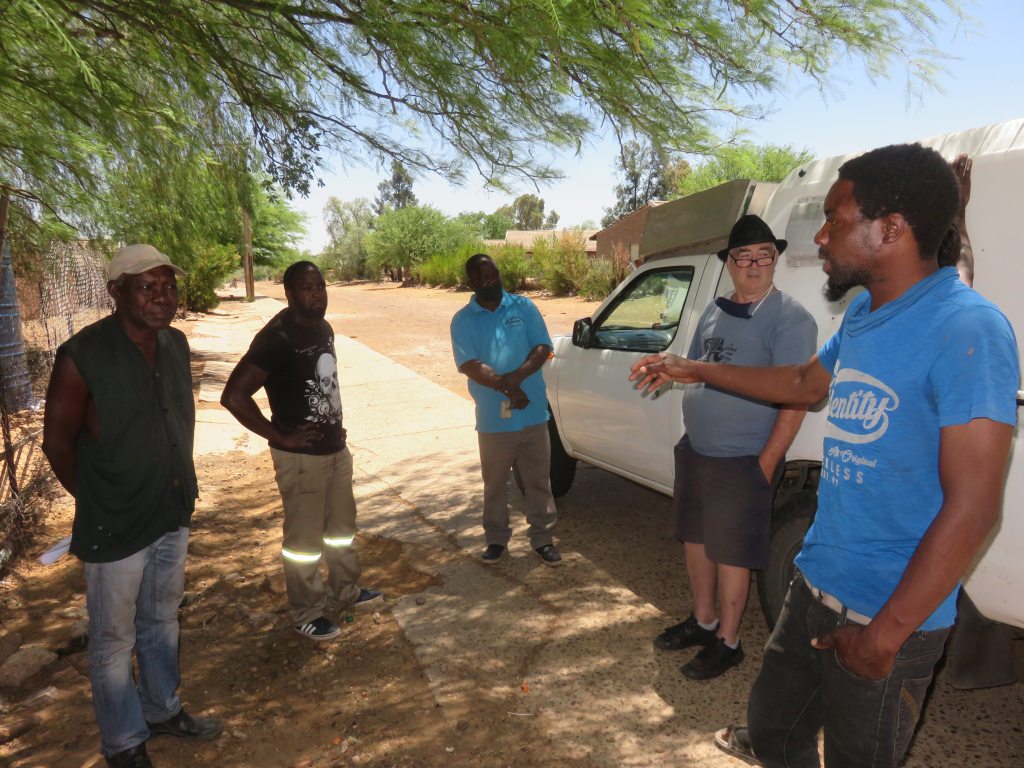 We did speak to a group of war veterans. Why don't they go back to Angola, the general answer, yes, but what will we do there? Here, at least, they get a pension, over there they get nothing.
We did speak to a group of war veterans. Why don't they go back to Angola, the general answer, yes, but what will we do there? Here, at least, they get a pension, over there they get nothing.
 We were there a few days before the municipal election of 2021. Of the election posters it was only the Democratic Alliance that was present, with Wilma Maritz for councillor, the other parties didn't bother. Checking the results for ward 12, I see that the DA got the majority vote. Unfortunately that was not enough, I am not sure how this works, but it was the ANC that got the counsellor's job. We met her during our travels.
We were there a few days before the municipal election of 2021. Of the election posters it was only the Democratic Alliance that was present, with Wilma Maritz for councillor, the other parties didn't bother. Checking the results for ward 12, I see that the DA got the majority vote. Unfortunately that was not enough, I am not sure how this works, but it was the ANC that got the counsellor's job. We met her during our travels.
School
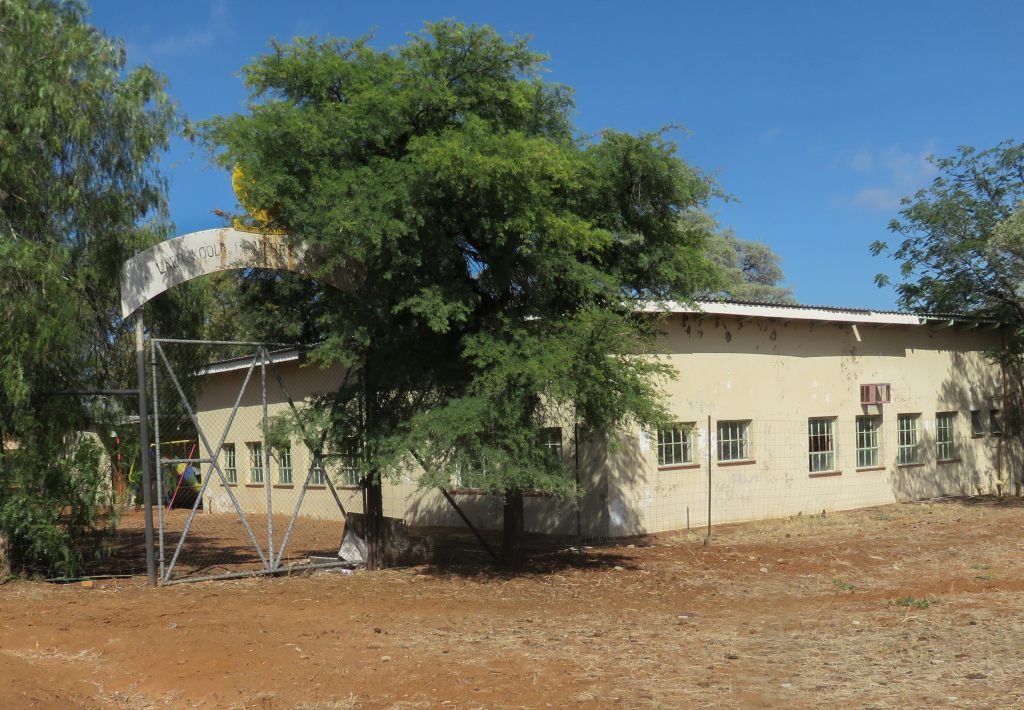 There was a primary school in town, that was the Pomfret Primary School, see picture. Note that the building still has its windows, that is because until recent time it was a children's home. A problem occurred when the person running it received a grant from the government and ran away with it. One of Wilma's (see above) projects is to get it going again.
There was a primary school in town, that was the Pomfret Primary School, see picture. Note that the building still has its windows, that is because until recent time it was a children's home. A problem occurred when the person running it received a grant from the government and ran away with it. One of Wilma's (see above) projects is to get it going again.
 A new school was built at the edge of the township. I am not sure when it was built. Going to Google Earth history, it first appeared on the picture of 2007, the previous view Nov 2006 shows what looks like construction activities.
A new school was built at the edge of the township. I am not sure when it was built. Going to Google Earth history, it first appeared on the picture of 2007, the previous view Nov 2006 shows what looks like construction activities.
The school looks like is still in good shape, although it doesn't seem to run on full capacity. One observation, there are a number of long drop toilets away from the buildings. These were not there in the early pictures and first appeared on Google Earth in 2013. The reason must have been the water crisis. Perhaps one should alert the government that there are still some long drops that need to be eradicated, I suppose replaced with WC's, what water would they be using?
grave yards
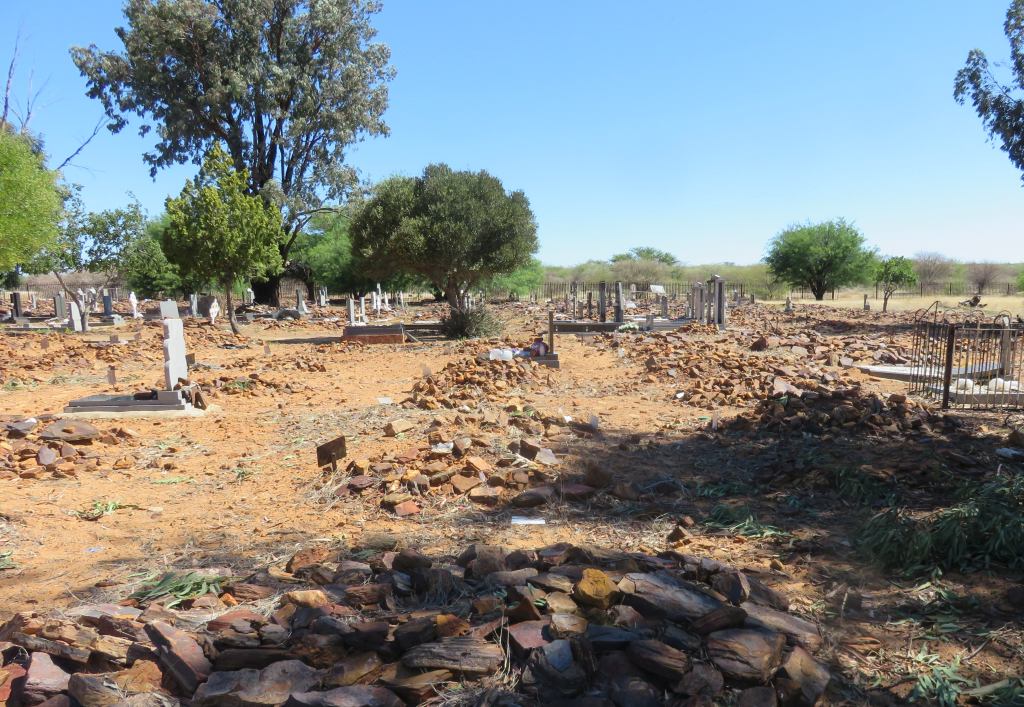
 The cemetery contains a large number of graves, most of those that had a head stone are of soldiers from the 32 Bat, as the one shown in the picture on the right. A pity I didn't explore the place further, there must be graves from the mining days. A special grave, I thought, was
The cemetery contains a large number of graves, most of those that had a head stone are of soldiers from the 32 Bat, as the one shown in the picture on the right. A pity I didn't explore the place further, there must be graves from the mining days. A special grave, I thought, was 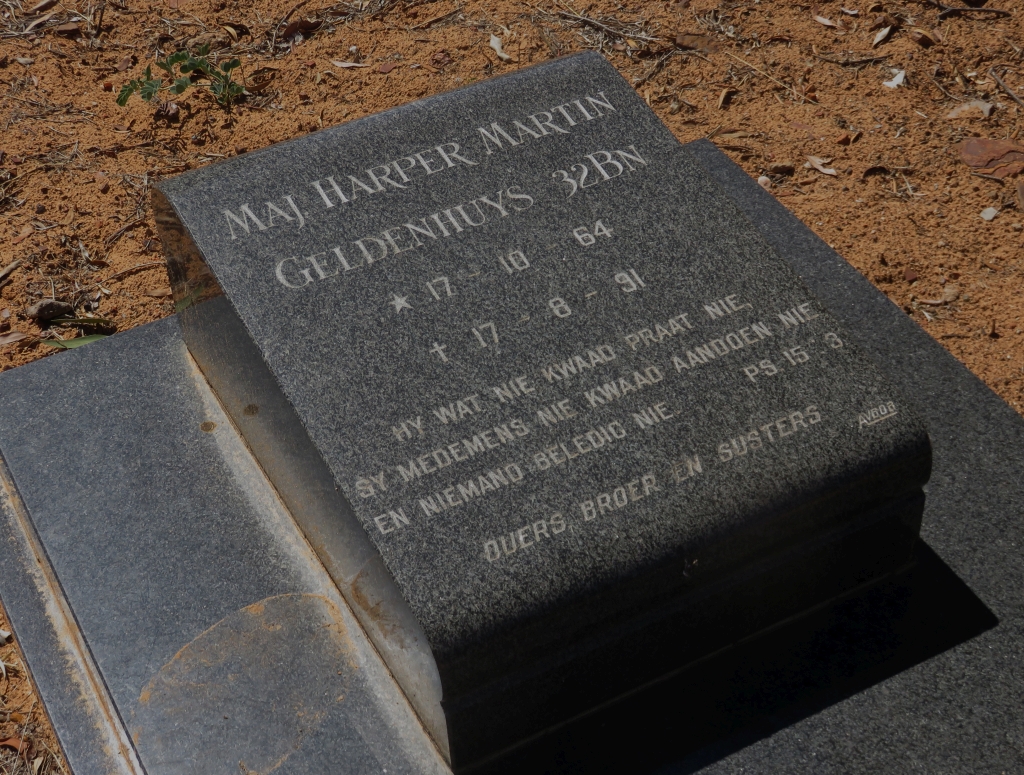 that of Major Geldenhuis. Is it that he preferred to be buried with his comrades rather than repatriated to his family?
that of Major Geldenhuis. Is it that he preferred to be buried with his comrades rather than repatriated to his family?
In town, near the shopping centre is a small grave yard of just four graves. I presume they go back to the time when this was a farm.  I have deciphered the inscription, sometimes this was difficult. The places where I had doubt have been marked with a (?). The four gravestones read: Renier Klem,23-07-1928,06-02-1986; Aletta Elizabeth Klem, ne Crouwkamt(?), 21-Aug-1903, 19-Dec-1947(?); Hermanus Johannes Klem, 6-Jan-1896, 30-June-1967 and a child's grave Stepanus(?) Jacobus de Lange, 6-2-1952, 21-7-1952.
I have deciphered the inscription, sometimes this was difficult. The places where I had doubt have been marked with a (?). The four gravestones read: Renier Klem,23-07-1928,06-02-1986; Aletta Elizabeth Klem, ne Crouwkamt(?), 21-Aug-1903, 19-Dec-1947(?); Hermanus Johannes Klem, 6-Jan-1896, 30-June-1967 and a child's grave Stepanus(?) Jacobus de Lange, 6-2-1952, 21-7-1952.
some concluding remarks
 I have to come back to my opening statement, the town without hope, and reconsider that. There are people living there and those people want to live there, to them Pomfret is home. So, there must be hope. The main problem is lack of income generation, they need jobs, businesses. But, how does one get them to such a remote place?
I have to come back to my opening statement, the town without hope, and reconsider that. There are people living there and those people want to live there, to them Pomfret is home. So, there must be hope. The main problem is lack of income generation, they need jobs, businesses. But, how does one get them to such a remote place?
One of the ex-soldiers we met showed us his discharge papers from the army. What I thought was significant is that at the time he was stationed in Ermelo and at the end decided to come home to Pomfret.
References
Ref 1.: H.P.Hart, 'Asbestos in South Africa', Journal of the SA Institute of Mining and Metallurgy, June 1988
Ref 2.: Anthony Hocking, Kaias & Cocopans - The story of mining in South Africa's Northern Cape